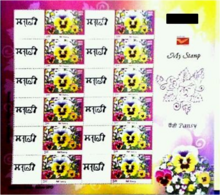Marathi language

Marathi language (मराठी Marāṭhī [məˈɾaʈʰi]) is an Indo-Aryan language. It is the official language of Maharashtra state of India and is one of the 23 official languages of India. There were 83 million speakers in 2011; Marathi has the third largest number of native speakers in India.] And it is 10th most spoken language in World. The major dialects of Marathi are called Standard Marathi and Warhadi Marathi. There are a few other sub-dialects like Vadvali, Samavedi, Koli. Standard Marathi is the official language of the State of Maharashtra.
Quotes
[edit]- Marāṭhī language is an Indo-Aryan language of western and central India. Its range extends from north of Mumbai (Bombay) down the western coast past Goa and eastward across the Deccan; in 1966 it became the official language of the state of Mahārāshtra. The standard form of speech is that of the city of Pune .
- Encyclopedia Britannica in: Marāṭhī language, Encyclopedia Britannica
- Descended from the Mahārāṣṭrī Prākrit, Marāṭhī has a significant literature. Books are printed in Devnāgrī script, which is also used for handwriting, although for handwriting there is also an alternate cursive form of Devnāgrī called Modi. Eastern Hindi is the Indo-Aryan language most closely related to Marāṭhī. Like Hindi, Marāṭhī has lost most of its inflectional system to indicate case, using instead postpositions (like prepositions, only following the word) with an oblique “case” to serve the function originally filled by inflection.
- Encyclopedia Britannica in: "Marāṭhī language"
Language Change: Lexical Diffusion and Literacy
[edit]
Goparaju Sambasiva Rao in: Language Change: Lexical Diffusion and Literacy, Academic Foundation, 1 January 1994.
- Initially, the Fort William College and the American and Scottish Missions pioneered Marathi language development.
- In: p. 46.
- During the period before printing was introduced the major part of written Marathi literature consisted of long poems written in simple meters.
- In: p. 47.
- Literature was communicated to the rest of the population through oral religio-cultural presentations. Marathi prose literature was smaller in volume and restricted to historical chronicles, administrative correspondence, accounts, etc. It was also written and copied by professional scribes.
- In: p. 48.
- [Marathi] is a language less regular and less definite than English and being only a spoken language inconceivably less apprehensible and less susceptible of rigid interpretation.
- Molesworth in: p. 48.
- During the pre-printing era, Marathi was written in two scripts : Modi (Moorh) and Balbodh (Devnagri). Balbodh was mainly used for writing poetry and Modi for writing prose. When books were printed in Marathi, the selection of one of the scripts became a problem. In the beginning both scripts were used. The types of devnagri were cut and applied to the Sanskrit and Hindi languages but Modi script was in use for Marathi.
- In: p. 48.
- As reading and writing were restricted to only high caste people who were either Sanskrit scholars, professional scribes, or rulers.... literature was accessible only to them and despite a thousand years of tradition of writing, newly arrived foreigners got the impression that Marathi is merely a spoken language without a serious literature... When books were printed in Marathi, the selection of one of the scripts became a major problem.
- In: p. 48.
- Books in the Maratha language are generally written in Devnagri character, but the character commonly used in business is the Moorh. The system of that alphabet and Devnagri is the same.
- William Carey in Garmmar of the Marathi Language, in p. 49.
- Although in the Maharatta country the Devnagri character is well known to men of education yet a character is much smaller and varies considerably in form, from the Nagari, though the number and power of the letters nearly correspond.
- William Carey in Grammar of the Marathi Language, in p. 49.
- Conscious efforts of evolving a uniform standard variety of Marathi were made by both Marathi scholars and British officers. Dadoba's concern about a uniform standard can be seen in the preface of his grammar.
- William Carey in Grammar of the Marathi Language, in p. 49.
- Before printing and the advent of the British, variations of language on all levels of language use were not felt to be a problem. The print media, and the preparation of school books under central governmental control according to precise criteria were the most important forces in the creation of uniform norm which in turn stabilized the spoken norm of Marathi.
- In p. 58.
A Comparative Study of Hand written Marathi Character Recognition
[edit]
P.E.Ajmire, RV Dharaskar, V M Thakare in: A Comparative Study of Hand written Marathi Character Recognition, International Journal of Computer Applications, 2012
- Although there are many scripts and languages in India but not much research work is done for handwritten Marathi characters. Marathi handwritten character recognition is the challenging task in the pattern recognition field.
- Marathi is an Indo-Aryan language spoken by about 71 million people mainly in the Indian state of Maharashtra and neighbouring states. Marathi is also spoken in Israel and Mauritius. Marathi is thought to be a descendant of Maharashtri, one of the Prakrit languages which developed from Sanskrit.
- Marathi first appeared in writing during the 11th century in the form of inscriptions on stones and copper plates. Marathi was written in Modi script — a cursive script which minimizes the lifting of pen from paper while writing. Most writings of the Maratha Empire are in Modi script. However, Persian based scripts were also used for court documentation.
- With the advent of large scale printing, Modi script fell into disuse, as it proved very difficult for typesetting. Currently, due to the availability of Modi fonts and the enthusiasm of the younger speakers, the script is far from disappearing.
- Now, Marathi is written in the Devnagri script, a set consists of 16 vowels
| Devanagari | अ | आ | इ | ई | उ | ऊ | ऋ | ए | ऐ | ओ | औ | अं | अः |
|---|---|---|---|---|---|---|---|---|---|---|---|---|---|
| Transliterated | a | ā | i | ī | u | ū | ṛ | e | ai | o | au | aṃ | aḥ |
| IPA | /ə/ | /aa/ | /i/ | /eː/ | /u/ | /unː/ | /ru/ | /ea/ | /əi/ | /o/ | /əun/ | /əm/ | /əɦə/ |
and 36 consonants
| क | का | कि | की | कु | कू | के | कै | को | कौ | कं | कः |
| ka | kā | ki | kī | ku | kū | ke | kai | ko | kau | kaum | kah |
क ख ग घ ङ च
छ ज झ ञ ट ठ
ड ढ ण त थ द ध
न प फ ब भ म
य र ल व श ष
स ह ळ क्ष ज्ञ
k kh g gh dm c
ch j jh tr ṭ th
ḍ ḍh na t th d dh
n p ph b bh m
y r l v sh sha
s h la ksh dny
making a total of 52 letters. It is written from left to right. Devnagari used to write Marathi is slightly different than that of Hindi or other languages.
- 'Modi' was in use till the time of the Peshwas (18th century). This script was introduced by HemadPanta, a minister in the court of the Yadava kings of Devgiri (13th century). This script looked more like today's dravidian scripts and offered the advantage of greater writing speed because the letters could be joined together. Today only the Devnagari script is used which is easier to read but does not have the advantage of faster writing.
- The script currently used in Marathi is called 'Balbodh' which is a modified version of Devnagri script. From this script Marathi language has 12 common vowels and for this the database is created. Vowels are the soul of the speech and sounds of the language. In Marathi vowels are usually written in abbreviated symbols or forms.
- From the 13th century until the mid-20th century, it was written with the Modi alphabet. Since 1950 it has been written with the Devnagri alphabet.
- Modi script is a Brahmi based script used primarily for writing Marathi and in some cases other languages like Hindi, Gujarati, Konkani, Tamil and Telugu.
- Modi script derives from Nagari family of script. Importance of Modi is because it was the official script for all administrative purposes in the 16th century. When the Maratha dynasties came in power they adopted also continued it as official script through the 17th century and it remained so until the middle of the 20th century. Changing socio-political conditions gradually pushed Modi out of its official use and was replaced by the Devnagri script, known as Balbodh
- In recent years interest in Modi script has increased and researchers and enthusiasts are reinventing this cultural and historical heritage. There are many of Modi documents preserved not only in India but also in other Asian and European countries. While the majority of Modi documents are official records, land records and other administrative documents, the script is also used in education, journalism and other routine activities before the 1950s.
- Anshuman Pandey (2011)
- Modi script has only single “eekar I” and “ookar u”, which minimize grammatical mistakes.
- The Modi letters are syllables as they cannot be drawn without the inherent vowel sign “Kana”.
- Modi has undergone a series of changes and it reflects the socio-political and cultural changes that occurred in the period when Modi was prominently used. The earliest form is of the 12th century, known as "Adyakalin (आद्यकालीन)‟. It underwent a change during the 13th century and is known as “Yadavakalin (यादवकालीन)” followed by “Brahmhkalin (ब्रह्मकालीन)” of the 14th-16th century. The well-known “Chitnis” form developed during the “Shivakalin (शिवकालीन)” of the 17th century. In the 18th century the “Peshvekalin (पेशवेकालीन)”, style of Modi gained prominence and had variations like “Chitnisi, Bilavalkari, Mahadevapanti, and Ranadi”. The final stage of Modi is associated with English rule and is called “Anglakalin (आंग्लकालीन)”. These forms were used from 1818 until 1952.
- Anshuman Pandey (2011)

